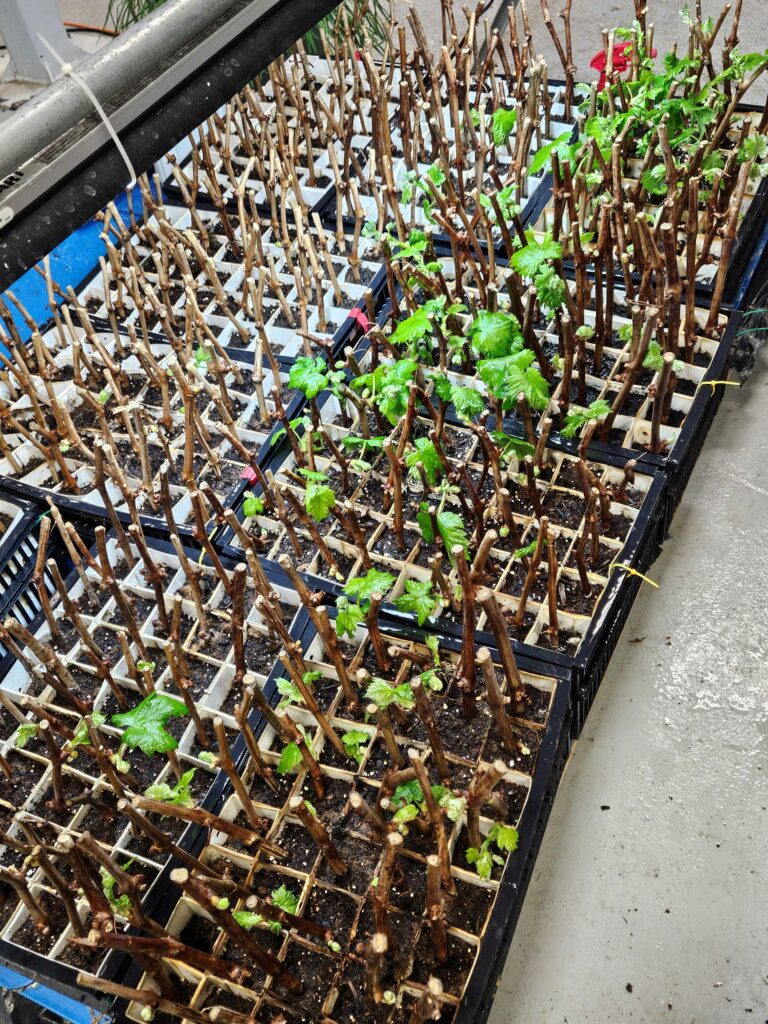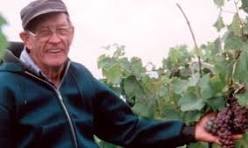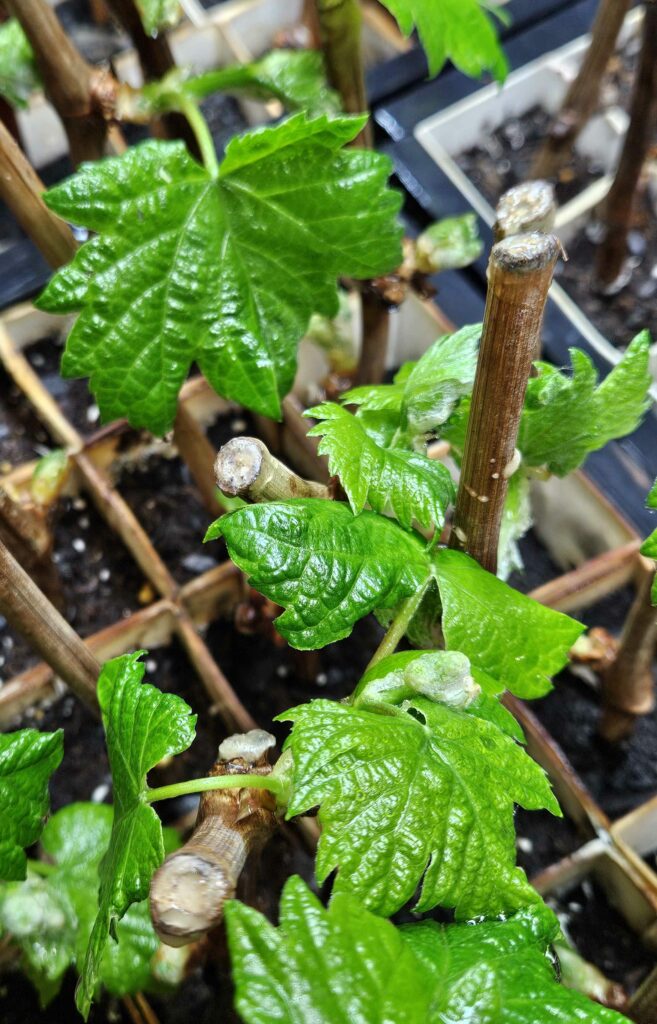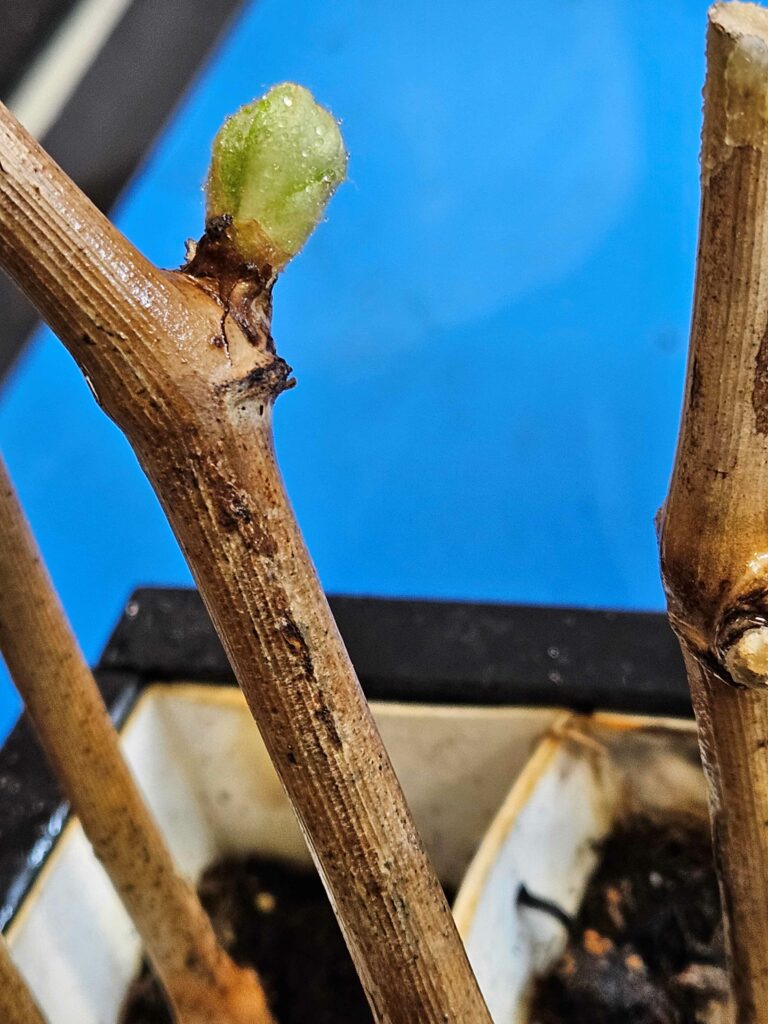
Starting new grape plants this time of year is something I do. Annie, our media person was walking through the winery and saw those 2024 grape cuttings and said, “you should blog about what you’re doing here, people would like to know.”
So here is to hoping you want to know?
Starting new plant starts this time of year is something I’ve done for a while. Either to fill in vineyard gaps or as in this case to expand some experiment varieties with permission from the breeder.
I started this year by putting roughly 560 vine cuttings into potting soil and 2x2x6 inch, open ended perforated boxes. There are 40 of those square rooting boxes per flat. These cuttings are leafing out now and Annie says, “they look like something now that they have green on them.” “So, blog about it.”
As I said, with permission from the grape breeder, Ed Swanson of Pierce, NE, I am once again expanding the number of plants in our vineyard with two (2) of his dry red varieties, Merchette and the yet to be named variety known only as cultivar #10-W-14.

Ed has been working on creating new varieties for perhaps 35+ years. Ed and his wife Holly opened Nebraska’s first winery in about 1988 and have since closed the winery which carried the name “Cuthills’. Ed continues to work toward releasing perhaps half a dozen varieties that he says, “have promise”. Ed has had other varieties that just didn’t quiet meet his strict criteria for release onto the market, even though some, myself included are anxious for something that could change Nebraska and Midwest dry red wines forever.
One of Ed’s never released varieties was Temparia. As I recall this variety had considerable interest among winemakers. It had deep red color, relatively good tannin structure and flavor profiles, but Ed just didn’t like some technical aspects.
I remember a judge from Illinois that I met at the St. Louis conference. She had tasted Temparia at one of Ed’s presentations and for several years, would email or call me asking about when Ed was planning to release Temparia. She wanted some Temparia plants in the worst way, but as Ed tells it, “there were herbicide sensitivity issues as well as some flavor profile issues with Temparia”. Thus, he chose never to release it.
Years ago, I recall Ed telling stories of Elmer Swenson of Wisconsin. Ed visited Elmer and the two talked grape breeding. Elmer is considered the godfather of cold climate grapes in the US. Elmer lived in Wisconsin, but worked for the viticulture department at the University of Minnesota as a field hand.
At conferences, over a glass or two, maybe three, and perhaps an hour or two, Ed unwrapped story after story, entertaining me with he and Elmer’s experiences running through the Swenson Vineyard identifying grape crosses Elmer was working on. Elmer was short in stature, while Ed is not. Elmer about lost Ed as he could get under the wires easier. Ed had to hustle just to keep up with this 80 year old. They had a strong relationship and I hope that soon, you will benefit from their field work as well.

Well, shortly after the new millennium, history repeated itself. Ed, ran me through his Peirce vineyard one day in much the same way Elmer had Ed years before. Cuthills was located west of Pierce (north of Norfolk, you know-Johnny Carson-ville). Ed had the parentage of every test variety memorized and after about the 10th time of telling me this was a riparian X tempranillo cross (which you could tell by the leaf shape) Ed gave me a quiz and asked what’s the parentage of this one?
I felt as if I was back in D.P. McGills UNL college genetics class. Professor McGill was famous for his oral quizzes too. In this case, Ed said you know what this one is, right? I was supposed to say riparian X tempranillo, but froze like a deer in the head lights for fear of miss identifying what I knew.
Anyway, after decades of grape breeding, Ed finally has these two varieties and perhaps 3-4 others in certification testing down in Missouri. This certification process can take perhaps 5-10 years to collect the defining information and characteristics for patenting. In the mean time Ed and I reached a non-propagation agreement (with written permission) during this time of testing. You see until Ed receives his patent; he cannot sell any of his varieties, BUMMER for Ed and Midwest lovers.
My hope is to reach sufficient numbers of the variety to either make a new varietal wine of these specific dry red wines, or blend the juice with something like Petite Pearl to enhance its tannin structure. Either way, I believe those of you who enjoy good dry red wines, will finally have another dry red to enjoy. One with lower acid and one that is Nebraska grown.

Here at Miletta Vista, in 2023, the Merchette produced a reasonable amount of tannin rich fruit which was added to our Petite Pearl to enhance structure. Half of that 2023 vintage is now in barrels and will be blended with unoaked wines when it’s thought the time is right.
Anyway, in January, I cut the 12-14 inch sticks from our 2023 vineyard growth. After eliminating cane borer damage, those cuttings were rubber-banded them into bundles of 20. The bottom cut end was wrapped in a damp paper towel. After a month setting in the bottom of a refrigerator, I dipped the top of the cuttings in hot bees wax to prevent dehydration, plus, it sealed the cut wood to prevent microbial infections during propagation.
After folding and stacking 40 boxes per flat, the cuttings were dipped in a strong rooting hormone to stimulate root growth. Then each twig was placed in potting soil. Once the flat of 40 was full, they were watered. Then, as any seasoned farmer, you wait. You wait the prescribed amount of time hoping things are alive. In this case, about a month goes by before the stick sucks up enough water to force bud swell. After swelling the prescribed amount, the buds break and the leaves begin to emerge. Then a seed cluster emerges, which is clipped in order to divert all energy to producing leaves, stems and roots.

Miletta Vista uses the much cheaper soil applied fertilizers for our base needs, but apply much needed micro nutrients using foliar application at times of specific nutrient needs. However, that’s a topic for another day.
The 9% nitrogen in this solution promotes stem and root tissue elongation. The 18% potassium and 18% phosphorous promotes root growth and root strength. The trick is not to over applying the fertilizer, thus burning the tender tissue with too many salts, which the acid-based fertilizers are composed of.
So, there you go, at this early stage of spring and plant growth, this grape farmer must remember patience. As they say in football, let the play develop. In this case let the plant tell you what it needs and when its ready to be put in the ground.
With all that background on our 2024 cuttings, lets revisit what we saw from the 10-W-14 grapes in 2023. The grape produced a dark heavy bodied wine. One could call the color inky, with a burgundy rich color and worthy of the descriptor, “heavy bodied”. Flavors were fruity. Reminiscent of perhaps a Merlot with moderate to light tannin structure. Lighter in tannin structure than the Merchette by a skosh.
The 10-W-14 plant is easy to grow. Swanson aptly describes it as almost bullet proof with regard to being disease resistant. It also exhibits resistance to the herbicide 2-4-D, which is a huge selling point for growers. In our case, it even showed some resistance to that nasty herbicide, dicamba. From everything I’ve experienced thus far, growers will love 10-W-14 once it’s released. It’s an easy keeper and good producer.
Merchette offers rich color, good fruit flavor and plenty of tannins. Go Big Miletta Vista Reds!!